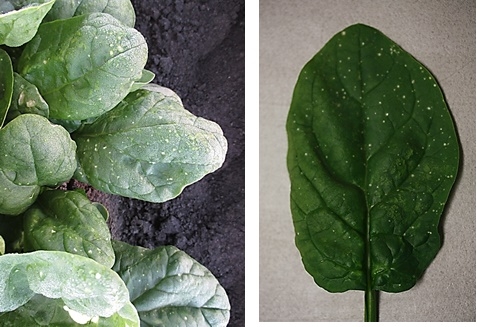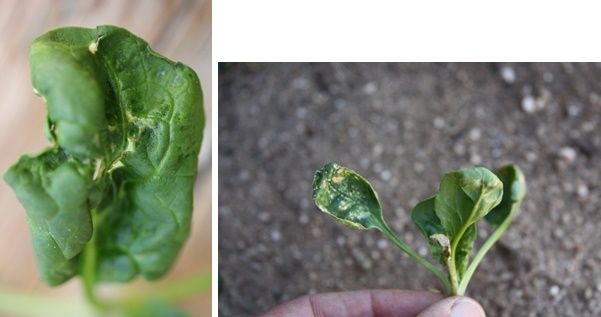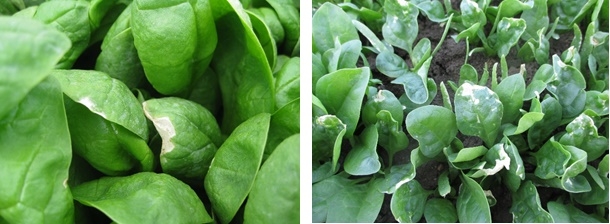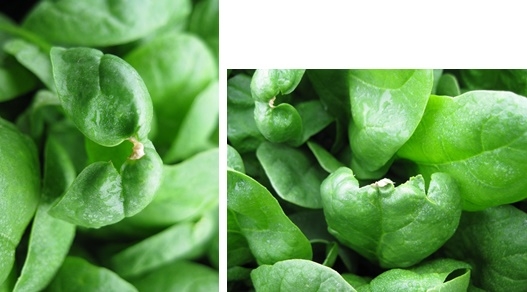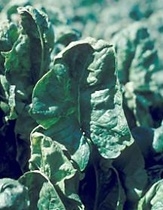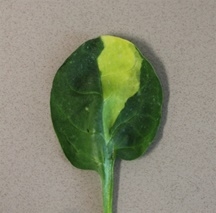Leaf spots are a common issue that affects spinach and reduces its salability. Spots on spinach leaves are caused by both biotic and abiotic influences. Insects, such as leafminers, frequently cause spots on spinach leaves. Female leafminers stipple spinach leaves by puncturing the leaf surface with their ovipositors and then feeding on plant sap that exudes from the holes. The stippled areas often occur in clusters and have a characteristic look due to the broken epidermal cells in the center of the stipple (photo below).
Diseases that cause spots on lettuce include the following: Cladosporium causes round, tan lesions that have dark green spores and mycelia in the center of the spots (http://ipm.ucanr.edu/PMG/r732100311.html); Anthracnose lesions start as dark green water-soaked lesions that later turn tan with black fruiting bodies in the center (can be observed with a good hand lens, http://ipm.ucanr.edu/PMG/r732100211.html); Stemphylium causes circular lesions, but no fungal fruiting bodies or mycelia occur in the lesions making it difficult to distinguish this disease from abiotic causes (http://ipm.ucanr.edu/PMG/r732100411.html).
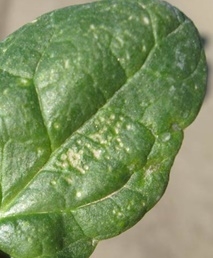
Abiotic leaf spots on spinach are caused by a variety of factors. The most common cause is from burn caused by herbicides, other pesticides or fertilizers; in addition, water and other stresses can cause spotting or lesions on spinach. Spinach leaves are quite sensitive to chemicals and will readily respond to them by developing chlorotic or tan colored necrotic areas. The size and distribution of the lesions can often provide clues as to the cause of the issue. For instance, spots caused by herbicides or other chemicals (Photos No. 1) often have a characteristic pattern which can reveal if the burn was caused by spray drift, herbicide on dust or even a direct spray. Spray drift or lift off of oxyfluorfen often causes small diffuse spotting on the leaves. The location of the affected plants in the field can indicate the direction that the chemical came from. Also, examining the pattern of the lesions on the plant can give an indication when the drift incident may have occurred, depending on which age of leaves are affected; for instance, younger leaves may be unaffected because they were protected down in the crown of the plant when the incident occurred. Also, if only the outer edge of leaves are affected, this may indicate that the base of the leaves were protected by shingling of other leaves; this symptom often helps to confirm that you are dealing with a drift issue vs some other cause. In many of these types of situations, having some background information about recent spray applications in the vicinity of the field helps piece together how and when the incident occurred. Spotting on the weeds also provides confirmation of the cause of the incident. Distortion of the leaves (Photos No. 2) occurs when the necrosis occurs early in the development cycle of the leaf; in this situation, the expanding young leaf continues to develop around the dead lesion and results in distorted growth. Chemical issues can also cause a sub-lethal response in spinach leaves which results in chlorotic lesions (Photos No. 3).
Other chemicals that commonly cause burn on spinach include salts. Salts in water can cause spotting and marginal burns on spinach (Photos No. 4), but it is rare for water to be salty enough to cause this issue. However, water-run injections of fertilizer are salty enough if the injected fertilizer is not adequately rinsed from the irrigation lines after the injection. Fertilizer burn from water runs typically look different than spray burn because the lesions often occur along the edge of the leaves and are typically larger and blotchier (Photos No. 5). Sometimes growers are surprised that their spinach was burned from fertilizer because they routinely apply fertilizer through the sprinkler with no issues; however, if the clean-out phase of the injection was not long enough, then fertilizer burn can readily occur. Topdress applications with dry fertilizer at the 1st – 2nd true leaf stage can also cause burn on spinach leaves if the fertilizer prills stick to moisture on the leaves (Photos No. 6).
Most of the spotting that we see on spinach is from the above-mentioned causes. However, other issues that can cause defects on the leaves include water stress (Photos No. 7) which is often tied to hot spells. Water stress characteristically will occur in large blotches in the interveinal region of the leaf. It mostly occurs on older to mid-aged leaves and on various locations on the leaf. Hail damage (Photo No. 8) occasionally occurs in the spring and causes light green spots due to damaged epidermal cells that lets the green from tissue lower in the leaf to show through. Tipburn of spinach occurs in the spring when air temperatures increase, but soil temperatures are still cool. Under such conditions a localized deficiency of calcium develops out on the tip of the young leaf; as the leaf continues to expand, the necrotic tissue on the tip inhibits expansion resulting in a “hooded” shape to the leaf (Photos No. 9). Occasionally, chimeras are seen in spinach fields which are the result of a mutation that occurs in the meristem of the leaf; the resulting leaves have a dramatic calico yellow and green appearance (Photos No. 9).
1. Herbicide or other Chemical Burn

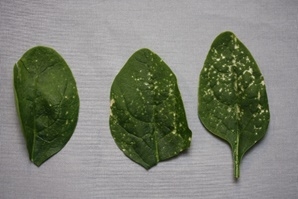
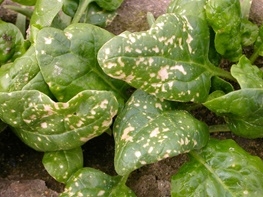
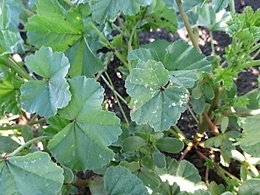
2. Necrosis and Distortion
3. Yellow Lesions
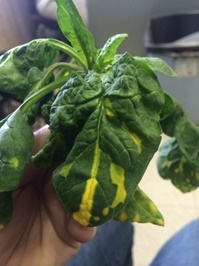
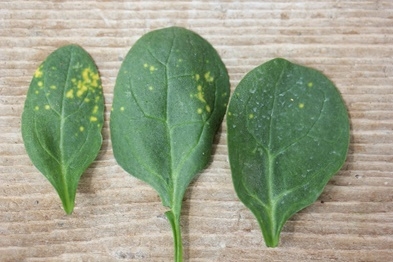
4. Salts in Water
5. Water-run Fertilizer Burn
6. Dry, Topdress Fertilizer Burn
7. Water Stress

8. Hail Damage
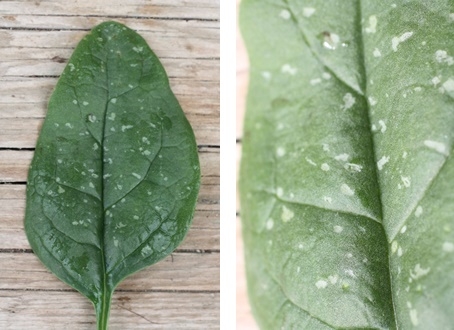
9. Other Leaf Issues
